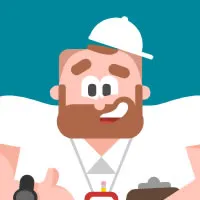How do you play singles pickleball?
Breaking it Down
Introduction
This guide will walk you through the basics of how to play singles pickleball. Though very similar to doubles pickleball, singles pickleball has a very different feel.The Court
Singles pickleball is played on the same court as doubles pickleball. Just like in doubles pickleball, in singles pickleball, there are four quadrants, and a non-volley zone. Jump on any pickleball court, and you're ready go to regardless of whether you're playing doubles or singles.The Basic Rules
Singles pickleball follows the same general rules as doubles pickleball. The main highlights are:- Follow the same serving rules for either a volley or drop serve.
- The ball must bounce once before the receiver returns the ball and must bounce a second time before the server hits the third-shot.
- After the serve, there are no restrictions on which side to hit the ball.
- The rally ends when the ball bounces twice, or out of bounds, any other fault occurs.
- Unless using rally scoring, players only get a point by winning a rally on their serve.
- Can't volley (hit the ball out of the air) while touching the non-volley zone.
Player Positions
The match begins with both players on their right/even side of the court. To begin every rally, the server will serve from the side of the court that corresponds with their score. If the server has an even score (0,2,4...etc), then they'll serve from the right side. If the server has an odd score (1,3,5...etc), then they'll serve from the left side. The receiver simply moves diagonally opposite from the server, since that's where the serve must land. Once the ball is served, players may move anywhere on their end of the court, provided they follow the non-volley zone rules.After a rally, if the server won the point, they'll shift sides to the side of the court that corresponds with their new score (either odd or even), and serve again. If the receiver wins the rally, they become the receiver and position themself on the side of the court that corresponds with their score, even if it was the same side where they began the previous rally.
Calling the Score
Because there is only one player on each "team", there is no need for the third number when calling the score. Simply say your score, as the server, then your opponent's score. For example, "seven, three". It's that easy!Strategy
Hit DeepWithout a partner, it's up to you to cover the entire court. Hitting the ball "deep" (close to the baseline) will give you more time to prepare for, anticipate, and react to your opponent's next shot.
Hit to the Corners
In singles pickleball, similar to tennis, it's often advantageous to hit the ball to the corners of your opponent's court. Doing so causes your opponent to move off center, and can allow you to take advantage of their position, not to mention causing them to tire quickly, running back and forth from corner to corner.
Aim for their Backhand
Though there are exceptions, a good guideline is to aim for your opponent's backhand. Most players have a more difficult time hitting a fast and accurate passing backhand shot than they do a forehand.
Rush the Net
Be ready and on the lookout. As soon as you hit a good shot that's deep, near a corner, and possibly to your opponent's backhand, you'll want to get to the non-volley zone line as quick as possible. This puts pressure on your opponent.
Hit it Where They Ain't
Singles picklebal is tiring! There's a lot more court to cover when it's just you. Though this strategy also applies to doubles pickleball, it's even more important in singles. Hit the ball to a spot on the court furthest from your opponent's position. Or, if they're moving in one direction, hit it behind them so they have to stop and go back the other way.
Pickleball Rules Facebook Group
Pickleball FYI mobile app
Asked on
May 22nd, 2023
May 22nd, 2023



